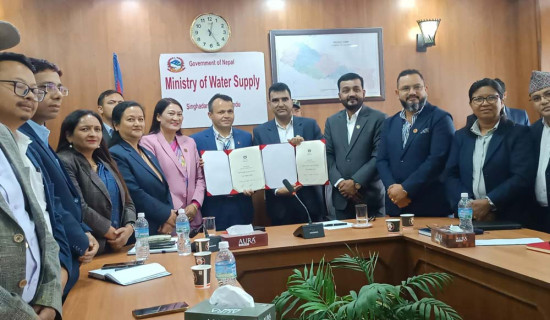- Friday, 9 May 2025
Hot Spell Hits Nation
As Nepal has recorded no rainfalls for the past three days or so, temperatures have been rising substantially, causing an adverse effect on the daily lives of people. Many parts of the country, especially the Terai region and other low lands, have continued to experience scorching heat over some days. Most Terai districts have recorded temperatures exceeding 40 degrees Celsius. According to meteorologists at the Meteorological Forecasting Division, the Kathmandu Valley’s temperature increased to 32 degrees Celsius on Wednesday (May 31). Temperatures may increase further in coming days with no possibility of immediate rainfall. The Division, however, has disclosed that some hilly areas witnessed light isolated rainfalls on Wednesday evening. Many people are likely to suffer from a number of heat-induced illnesses such as heat cramps, heat exhaustion, sunstroke and hyperthermia owing to their exposure to hotter than average conditions.
As per the World Health Organisation (WHO), rapid rise in heat gain compromises the body’s ability to adjust temperature, resulting in such illnesses. The global health agency also states that deaths and hospitalisations from heat-related complaints could rise swiftly when temperatures keep mounting. Besides, temperature extremes can also lead to deterioration of health of those with underlying conditions like cardiovascular, respiratory, and cerebrovascular diseases and diabetes. Health specialists warn that heat could also have critical indirect health effects because these conditions may lead to an alteration in human behaviour, the transmission of diseases, health service delivery, air quality, and vital social infrastructure such as energy, transport, and water supply. The magnitude and nature of the health effects of heat hinges on the timing, intensity and duration of a temperature rise, the level of acclimatisation, and the adaptability of the local population. During the hot season, more incidences related to snakebite are reported in the Terai districts. So, people need to take necessary precautions to remain safe from fatal snakebites, too.
In view of the prevailing life-threatening heat, some local levels in Jhapa district have announced the closure of schools for some days. This type of preparedness is expected to save schoolchildren from heat impacts. If the mercury level keeps on increasing, other local governments will also follow suit. Generally, monsoon rains in Nepal start from the second week of June every year. With the arrival of the monsoon rains, temperatures fall, giving a respite for the people. The Department of Hydrology and Meteorology (DHM) has already forecasted that this year’s monsoon will commence soon and come to an end by September 30. The DHM, however, has predicted the likelihood of less rainfall in the coming rainy season in the country, except for some areas in the eastern hills and the Terai belt.
However, the DHM has projected that there is a 35-45 per cent chance of heavy rainfall in the central and northeastern regions of the Koshi Province, the southeastern belt of the Bagmati Province, and most parts of the Madhes Province. This really demands that the authorities concerned make necessary preparedness to deal with the potential rain-induced disasters in those areas. But in other areas, there is a 35-55 per cent chance of low rainfall during the monsoon season. If the prediction proves right, the agriculture sector is likely to remain affected badly because most farmers depend on rains for irrigating their crops. It has also been predicted that the maximum temperature this year is expected to be higher than the national average. Global warming phenomenon has been blamed for the unprecedented happenings in climate and weather patterns.

















